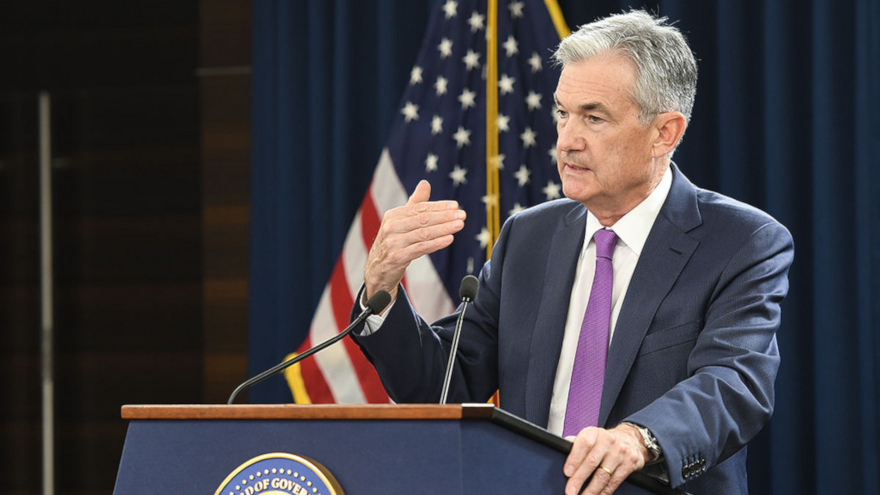As expected, Fed opens 2019 by keeping interest rates stable

Federal Reserve chairman Jay Powell, seen here during a news conference on Sept. 26, explained why policymakers kept interest rates stable. Photo courtesy of the Federal Reserve.
By subscribing, you agree to receive communications from Auto Remarketing and our partners in accordance with our Privacy Policy. We may share your information with select partners and sponsors who may contact you about their products and services. You may unsubscribe at any time.
DALLAS and WASHINGTON, D.C. –
What Comerica Bank chief economist Robert Dye projected to unfold this week came to fruition as the Federal Reserve had its first opportunity of 2019 to make an interest rate adjustment.
The Federal Open Market Committee decided to maintain the target range for the federal funds rate at 2.25 to 2.50 percent as all 10 members voted unanimously.
In its statement, the FOMC reiterated that it continues to view sustained expansion of economic activity, strong labor market conditions and inflation near the committee’s symmetric 2 percent objective.
“In light of global economic and financial developments and muted inflation pressures, the committee will be patient as it determines what future adjustments to the target range for the federal funds rate may be appropriate to support these outcomes,” the policymakers said.
Earlier this month, Dye shared a commentary that described how the Fed hinted that this outcome was likely when policymakers conducted their final gathering of 2018.
"Recent commentary by Fed chairman Jay Powell and his colleagues, and the minutes from the Federal Open Market Committee meeting of Dec. 18 and 19 shows an important but subtle change in Fedspeak. Powell has used the word ‘patient’ several times recently to describe the Fed's attitude toward more rate hikes for 2019. ‘Patient’ also shows up in the Fed minutes released this week,” Dye shared in a note released on Jan. 11.
Subscribe to Auto Remarketing to stay informed and stay ahead.
By subscribing, you agree to receive communications from Auto Remarketing and our partners in accordance with our Privacy Policy. We may share your information with select partners and sponsors who may contact you about their products and services. You may unsubscribe at any time.
“Recall that former Fed chairwoman Janet Yellen also used the word ‘patient’ to describe her attitude toward eventual rate hikes in early 2015,” Dye continued. “When pressed, Yellen said that being patient meant waiting a couple of meetings. Pressed further, Yellen implied that a couple meant about two.
“We should not hold Powell to a strict definition of patient or of a couple, but his choice of language appears to be purposeful,” Dye went on to say.
Powell hosted a news conference after this week’s latest policy announcement. In his prepared remarks, Powell further elaborated about how economic conditions have continued to shift since the FOMC last met.
“In addition, the case for raising rates has weakened somewhat. The traditional case for rate increases is to protect the economy from risks that arise when rates are too low for too long, particularly the risk of too-high inflation,” Powell said.
“Over the past few months, that risk appears to have diminished. Inflation readings have been muted, and the recent drop in oil prices is likely to push headline inflation lower still in coming months,” he continued. “Further, as we noted in our post-meeting statement, while survey-based measures of inflation expectations have been stable, financial market measures of inflation compensation have moved lower.
“Similarly, the risk of financial imbalances appears to have receded, as a number of indicators that showed elevated levels of financial risk appetite last fall have moved closer to historical norms,” Powell went on to say.
The Fed chair also acknowledged an array of turbulent elements that could have impact on policy decisions. Powell specifically mentioned policymakers “have seen some cross-currents and conflicting signals.”
Powell noted growth has slowed in some major foreign economies, particularly China and Europe. He described “elevated uncertainty” around several unresolved government policy issues, including Brexit, ongoing trade negotiations and the effects from the partial government shutdown in the United States.
“Times of economic uncertainty put a premium on the clarity and predictability of FOMC policy,” Powell said to close his prepared remarks. “We are committed to clearly explaining what we are doing and why we are doing it, both regarding the path of rates and also regarding management of the balance sheet.
“We believe that this transparency is how we can best contribute to macroeconomic stability,” he concluded.


